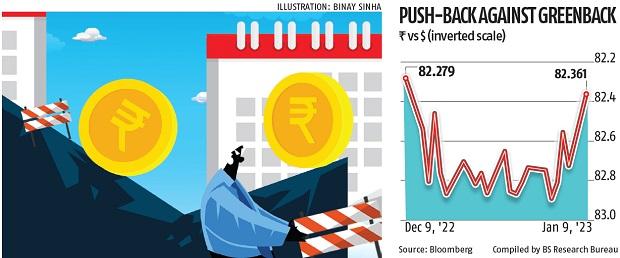The rupee strengthened to a one-month high against the greenback on Monday as data showing slowing wage growth and a decline in a key economic gauge in the US spurred hopes of the Federal Reserve slowing down the pace of its rate increases.
The Chinese yuan—driven by the country easing real estate regulations—also propped up the rupee, dealers said. A stronger yuan typically boosts other emerging market currencies.
The rupee closed at 82.36 per US dollar as against 82.73 on Friday. Monday’s closing for the rupee marks the strongest level versus the US dollar since December 9.
Data released late Friday showed that while job additions in the US continued at a healthy pace in December, average earnings grew at a slower pace than the previous month. Separately, data released by the Institute for Supply Management showed that US non-manufacturing PMI fell sharply in December from a month ago.
The data sets suggest that the Federal Reserve’s aggressive rate hikes since March 2022 have played some role in slowing down the US economy, potentially paving the way for the central bank to pare future tightening.
The US dollar index fell sharply on Monday, with the gauge at 103.71 at 3:30 pm IST as against 105.41 at the same time on Friday. Signs of slower Fed rate hikes could reduce the global strength of the US dollar, boosting emerging market currencies like the rupee.
“Indian rupee, in line with Asian currencies, strengthens and touches a one-month high. Looking at the recent high-frequency data and rebound in the risk assets we could see the rupee start catching up with the other Asian currencies,” said Dilip Parmar, research analyst, HDFC Securities.
“On the technical front, spot USD/INR has minor support at 81.90, the high of November 21 which coincides with an upward-slopping trend line adjoining the recent swing lows of 80.51 and 80.99. While on the higher side, 82.95 will be difficult to cross without the support of strength in the dollar index,” he said.

RBI steps in, forwards rise
After dropping to a fresh eleven-year low early in December, premiums on one-year dollar/rupee forward contracts have recovered significantly, largely owing to the Reserve Bank of India’s actions in the market, traders said.
The rise in the forward premia—essentially, the interest rate differential between India and the US—has aided the rupee by creating more conducive conditions for exporters to sell dollars. A lower forward premium helps importers by bringing down their hedging costs. For exporters, however, a lower forward premium implies a lower return—or carry—when they sell dollars.
The RBI used a ‘sell-buy’ swap, which entails selling dollars in the spot market and then buying them for a future date, traders said. The purchase of dollars in the forwards market pushes up the forward premium.
“The RBI did a sell-buy swap to take the premium higher. They were doing it on a daily basis. So the forward premium moved up from 1.62 per cent to 1.80 per cent in early December itself and then slowly moved up further—it had gone up to 2.30 per cent. There exporters started receiving (selling dollars) because they found that the differential has gone up quite a bit,” said Anil Kumar Bhansali, head of treasury at Finrex Treasury Advisors.
“The RBI was paying from the time of the last policy statement on December 7 to around last week,” he said. On Monday, the one-year dollar/rupee forward premium contract settled at 2.10 per cent.
The rupee was in December among the worst performers in the emerging markets pack, with sixteen currencies faring better than it. Among other factors such as a widening trade deficit a factor that had been cited by analysts was exporters’ reluctance to sell dollars due to the low forward premia.
The RBI’s moves in the forwards market may also have been aimed at ensuring that its reserves did not drop sharply even as it may have stepped in to stabilise the rupee through dollar sales in December. The rupee depreciated 1.5 per cent in December, heading close to the psychologically significant 83 per dollar mark.
“It looks like the RBI may have been selling in spot and buying in the forwards. It made sense. Firstly, the forward premium was becoming a disincentive for exporters and second the spot rupee was trading weaker because of which it looked like it might make a new all-time low so the RBI had to sell,” said Anindya Banerjee, VP – Currency Derivatives & Interest Rate Derivatives at Kotak Securities.
“Moreover, they didn’t want to lose reserves, so this mechanism acted as a hedge. One of the major supplies of the dollar which was missing in the market was the carry trade. Because the carry traders wouldn’t be incentivised at the low levels which had existed,” he said.





GIPHY App Key not set. Please check settings